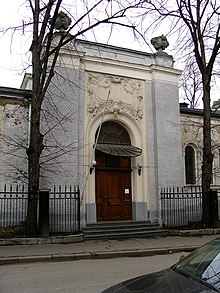William Walcot
| William Walcot | |
|---|---|

Gutheil House, 1902–1903
|
|
| Born |
10 March 1874 Odessa, Russian Empire (now Ukraine) |
| Died | 21 May 1943 (aged 69) Hurstpierpoint, Sussex, UK |
| Nationality | United Kingdom |
| Occupation | Architect |
| Buildings | Metropol Hotel, Gutheil and Yakunchikova mansions (all in Moscow, Russia) |
William Walcot (10 March 1874 – 21 May 1943) was a British architect graphic artist and etcher, notable as a practitioner of refined Art Nouveau (Style Moderne) in Moscow, Russia (as Вильям Францевич Валькот). His trademark Lady's Head keystone ornament became the easily recognisable symbol of Russian Style Moderne. In 1920s–1930s, he concentrated on graphic art and was praised as the best architectural draftsman in London.
William Walcot was born at Lustdorf, near Odessa in a mixed Scottish-Russian family. He grew up in Western Europe and South Africa, returning to Russia at the age of 17, and studied arts and architecture under Leon Benois at the Imperial Academy of Arts in Saint Petersburg. Later, he attended art schools in Paris. Walcot's career as an architect in Moscow lasted only six years, but he managed to leave a lasting heritage of refined, pure Art Nouveau. Unlike contemporary architects like Fyodor Schechtel, Walcot never ventured into Neo-Gothic or Russian Revival styles – his work is strictly Art Nouveau, in its English Decadent variety (according to contemporary Russian critics).
His largest and best known work was the Metropol Hotel, financed by Savva Mamontov. The spacious building, now operating as a hotel only, was conceived as a cultural center around Private Opera hall. In 1899, Walcot applied to the open contest with a draft codenamed A Lady's Head (Женская головка), earning the fourth prize and losing to Lev Kekushev. However, Mamontov discarded the professional jury decision, and awarded the design to Walcot (Lev Kekushev later joined the team as project manager). More than once, Walcot's original plans were changed in the process; in fact, there is little in common between the extant building and his 1899 draft (Brumfield, fig.56) – but the Lady's Head persisted in the main hall ornaments. The building, completed in 1905 after a devastating fire in 1901, was decorated by Mikhail Vrubel, Alexander Golovin, Nikolai Andreev and other artists. Participation of Victor Vesnin and Fyodor Schechtel, suggested by William Brumfield, has not been confirmed.
...
Wikipedia
